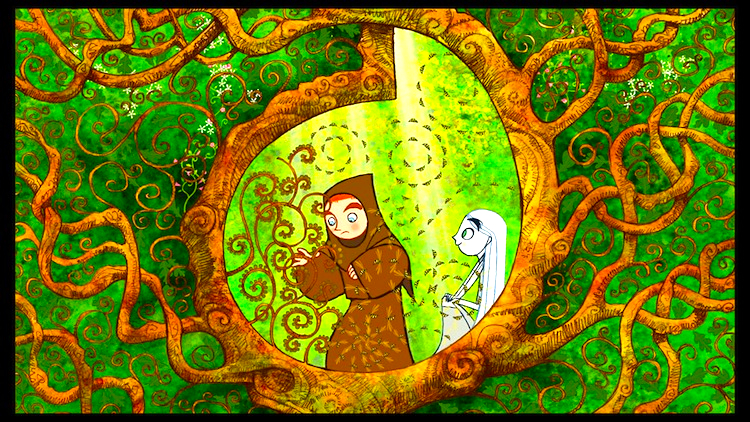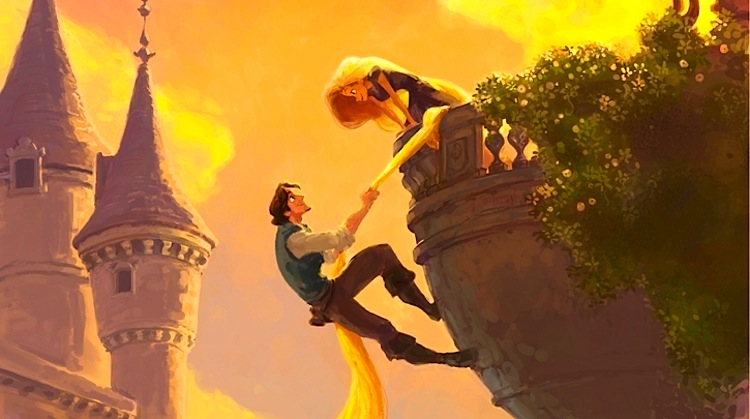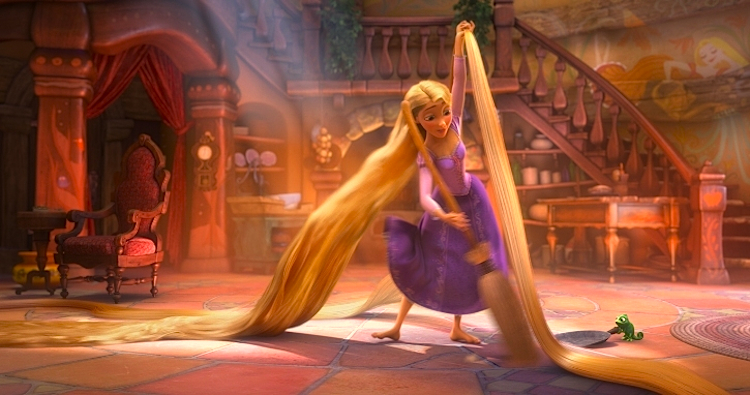By David Ross. Is Disney finally laying the ghost of its lost decades? To some extent it is. Its last, The Princess and the Frog (2009), laudably reprised the look and feel of the Disney Golden Age (see my comments here), while its latest, Tangled, builds on the example of Bolt (2008) and does its best to mime Pixar. Disney has not mastered what it takes to be the Pixar formula (which it never will because Pixar’s only formula is the rejection of formula), but even so Disney was wise to place itself under the supervision of Pixar chief John Lasseter, who is now chief creative officer of both companies. Disney’s recent films may not be the deepest or most poignant, but they are at least energetic and entertaining.
Tangled is the story of Rapunzel with a revamped plot for an age of campy glitter. In Disney’s telling, Rapunzel is not a peasant but a princess (inevitably), and her hair, which seems to be about fifty feet long, is both magical (cures wounds, reverses aging, etc.) and handy (recollect Indiana Jones with his whip). The old crone Gothel pilfers the golden-haired infant from the castle of her parents and sets her up in a tower as an all-purpose Botox substitute. She is eventually rescued, not by a prince, but by Flynn Rider, a charming rogue supposedly in the Errol Flynn vein but actually in the mugging mode of Brendan Fraser.
There’s no denying that the film is fast paced, action packed, and funny, and that Rapunzel’s hair makes a clever and innovative prop. My five-year-old daughter writhed in laughter throughout, especially enjoying the scene in which Rapunzel beats the crap out of Flynn with a frying pan and tries to stuff him in a closet (an axiom of kiddy humor: traumatic brain injury is always good for a giggle). In a just world, the horse Maximilian – a hilarious version of Hugo’s inexorable Javert – would be standing on four legs at the podium in March receiving the Oscar for best actor while Sean Penn restrains the impulse to clutch the throat of whoever happens to be sitting in front of him and to shake until certain silicone parts pop out of alignment.
What’s subtly wrong with the film is what’s wrong with so many post-Shrek kid movies. Filmmakers insist on a winking referentiality, as if fairy tales are dusty old irrelevancies that must be rescued by pop cultural in-jokes and Lettermanesque (now Stewartesque) insouciance. These Generation X artistes are aware enough to recognize clichés but not inventive enough to transcend them. In the end, the clichés appear in horn-rimmed quotation marks, but they are clichés all the same. In Tangled, every last facial expression and turn of idiom has an antecedent in some movie or TV show or music video. It would take a team of hyper-caffeinated Tarantinos to trace them all, but the aura of tedious familiarity is unmistakable. The tune “Mother Knows Best,” a pastiche of the controlling (Jewish? Italian?) mother delivered in belting Broadway style, gives the tenor:
Go ahead, get trampled by a rhino
Go ahead, get mugged and left for dead
Me, I’m just your mother, what do I know?
I only bathed and changed and nursed you
Go ahead and leave me, I deserve it
Let me die alone here, be my guest
When it’s too late
You’ll see, just wait
Mother knows best
Mother knows best
Take it from your mumsy
On your own, you won’t survive
Sloppy, underdressed
Immature, clumsy
Please, they’ll eat you up alive
Gullible, naive
Positively grubby
Ditzy and a bit, well, hmm vague
Plus, I believe
Getting kinda chubby
I’m just saying ’cause I wuv you
Mandy Moore, who plays Rapunzel, is the perfect pawn of this approach. Her medieval princess is a perky cheerleader type: a young Kelly Ripa in medieval drag. I can picture her wielding an iPhone, but not wielding a scepter.
Tangled is less heavy-handed than Shrek in this regard, and its jokes are somewhat less stupid, but its general approach is so unnecessary and evinces so little faith in the enduring power of mythic narratives. Movies like this entertain in the superficial sense, but at the cost of initiating young people in the traditions of Western imagination. The great Disney fairy tales of yore – Snow White and Sleeping Beauty especially – were unforgettable in their vivid realization of dim pasts and mythic destinies. They belong to the worlds of Grimm and Perrault, but also to the neo-medieval fantasy tradition of Tennyson and the Pre-Raphaelites, with Keats and Malory lurking in the remote recesses. Tangled, by contrast, is like a Steve Madden ad set in motion: encephalitic dolls bounce in a color-saturated wonderland that connects to nothing in our collective unconscious.
These objections, admittedly, are unlikely to be shared by anybody who is not on the lookout for signs of cultural demise. The average moviegoer will have no complaints, and the average little girl will resist her next haircut with tears and threats. By its own standards, Tangled is a success; it delivers the promised ‘fun.’

Tangled has its precise opposite – its anti-self – in the The Secret of Kells (2009), a masterful Irish cartoon that gives an fanciful account of the creation of the Book of Kells, one of the greatest medieval illuminated manuscripts (now housed at Trinity College, Dublin). Under constant threat from the invading northmen, the monks of Kells labor to complete their great book. Brendan, the young nephew of the abbot, is wonder-stricken by this labor and becomes a secret apprentice. He ventures into the forest to locate the necessary berries and there meets the streaming, gliding, shape-shifting Aisling, at fairy at once unsettlingly inhuman and lovable. Even more terrible, Brendan must venture into the cavernous depths to find a prismatic crystal upon which the monks’ work depends; the crystal turns out to be the eye of the snake-demon Crom Cruach, whom Brendan must defeat. In the end, the northmen ravage and burn the monastery and Brendan flees with the manuscript to continue the monks’ labor on his own, in a hut by the sea.
The Secret of Kells ponders the selflessness of the monks who toiled for decades in fire-lit scriptoriums to create their monuments of faith. In this sense, the film stands at the farthest possible remove from our own ethic of not particularly bothering. Beautifully and intricately rendered in the flat stylized manner of the Book of Kells itself, the film is full of dreamlike beauty and horror, evoking a world that has the fluidity and mystery of living imagination.
Tangled is a mirror held up to our silliness; The Secret of Kells is a looking glass in which we may for a time disappear.
Posted on December 6th, 2010 at 10:45am.


Nice review, I’ll have to find “The Secret of Kells” now.
I felt “Tangled” was a throwback to the second Disney “golden age”, where the gold was mainly from the money pouring in from ticket sales due to Broadway influenced movies like Little Mermaid, B&B, Lion King and Aladdin. Tangled seemed to owe a lot to Aladden and the unfortunate topical references, to which you refer, originate in the attempt to emulate Howard Ashman’s successful lyrics.
Since “Tangled” seems to be doing very well, I expect we’ll soon be seeing a spate of Disney CGI musicals to follow, all featuring virtual princesses.
I enjoyed Tangled, but this is a fair assessment of the film.